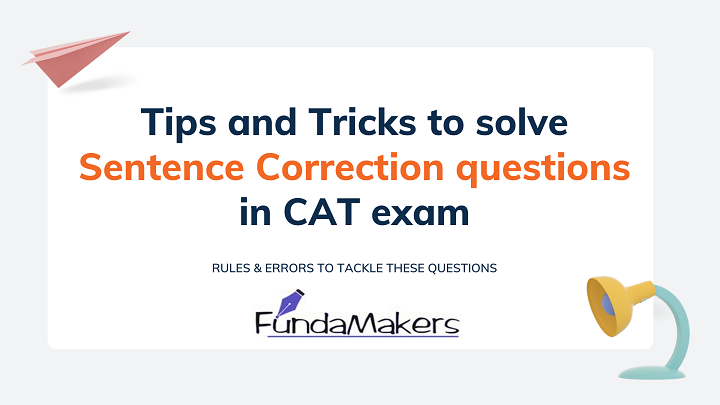Tips & Tricks to solve Sentence Correction questions
Sentence Correction or Error spotting is one of the most scoring as well as one of the trickiest topics in the Verbal Ability section of CAT. Although Sentence Correction Questions were not seen in the recent CAT Exam Papers these questions are a part of other management entrance examinations like NMAT, SNAP, TISSNET, etc. Sentence Correction Questions in CAT were last seen in CAT 2016. In this article, we will be learning some quick and efficient ways and important Tips & Tricks to solve Sentence Correction questions in the CAT exam.
The purpose of asking Sentence Correction questions in the exams is to test your grammar skills. You need to find out the grammatically incorrect part of the sentence and replace it with correct options. You can achieve the same by being aware of the fundamental rules of grammar and the correct usage of words. In case you are having trouble with the Fundamental rules of Grammar, then you can watch these 4 videos in which our VARC Expert, Mr. Surya Pratap Singh has discussed this topic in a much simpler manner which is easy to grasp.
You may find a part of the sentence, given in the question, in bold or underline and you have to replace it with the correct answer option. So you just need to find the grammatically incorrect part of the sentence and accordingly the grammatically correct answer.
Tips to solve Sentence Correction questions in CAT exam
To solve Sentence Correction Questions in CAT Exam or other management entrance exams, here are some important Rules and Errors which can be used to tackle Sentence Correction questions. These are:
1. Subject – Verb Agreement:
The verb used in the sentence should be in accordance with the subject.
i) They both should be singular or plural. Example:
– A boy is reading a novel (singular)
– The boys are reading a novel (plural)
ii) In case the subject is a collective noun, the verb will take a singular form. Example:
– The class is making a noise.
There are four collective nouns – cattle, poultry, police and gentry, with these nouns we use a plural verb and there are exceptions to the rule.
iii) In case the subjects are connected by ‘AND’, they will take plural verbs. Example:
– Gold and Silver are precious metals.
iv) In case there are two different subjects connected by ‘OR’, the verb is put matching the subject closest to it. Example:
– Sachin or I am going for the party.
– Sachin or Rahul is going for the party.
v) All the sentences that begin with EACH, EVERYONE and ANYONE will have a singular verb. Example:
– Every one of the boys loves to ride.
– Anyone has a pen, please.
vi) Confusion between I and Me: When two subjects or objects are joined by AND, we often do not know which form to use. Example:
– Jenny and I/me joined the book club: Here Jenny and ‘I /me’ are the subjects of the verb ‘joined’. Hence, the subject pronoun ‘I’ is grammatically correct.
– Jill took Justin and I/me to the shop. Here Justin and ‘I/me’ are the objects of the verb ‘took’. Hence, the object pronoun ‘me’ is grammatically correct.
Note- Whenever a comparison is made using “than” or “as”, the objective form of the pronoun is used.
vii) Usage of NEITHER…NOR and EITHER…OR: If both the subjects are singular, the verb will be singular. Example:
– Either the mother or the daughter has cooked the meal.
But when one of the subjects, joined by OR or NOR is plural, the verb must be plural and the subject should be placed near the verb. Example:
– Neither the teacher nor the students were present.
2. Parallelism error:
The different words/ phrases performing the same function should be used in the same format. Example:
- Sonia likes to dance, sing and cook. (Correct)
- Sonia likes dancing, singing and cooking. (Correct)
- Sonia likes to dance, sing and cooking. (Incorrect)
3. Repetition error:
Also called the redundancy error, this is the blunder of writing the same thing twice. Example:
– He returned back from Delhi. (Incorrect); He returned from Delhi. (Correct)
4. Modifier error:
An error to leave a participle without a subject. A modifier should be placed next to the subject it modifies. Example:
- Sitting in the garden, a scorpion stung him. (Incorrect as here, it is unclear who is sitting in the garden, the boy or the scorpion)
- Sitting in the garden, he was stung by a scorpion. (Correct)
5. Comparisons:
The comparisons made should be between two similar things. Example:
- The population of London is greater than any other city in India. (Incorrect)
- The population of London is greater than that of any other city in India. (Correct; the correct comparison is between the populations of both)
Rule-
- When the comparative degree is used then make sure that we exclude the thing compared from the rest of the class of things. Example:
- He is stronger than any man living. (Incorrect)
- He is stronger than any other man living. (Correct)
- In superlative degree, we must include the thing compared. Example:
– Soloman was the wisest of all men.
6. Error in Diction:
It refers to the error in the choice of words/ phrases. Common pair of words and phrases where you may face diction error are:
a) Few and Less: Few is used before countable nouns and Less is used before uncountable nouns. Example:
- There are a few children in the class today.
- There is less juice left in the jar.
b) Few and A few: Few is something negligible, hardly any while. ‘A few’ is equivalent to some. Example:
- Few persons can keep a secret.
- A few persons are convinced about the manager.
c) Little and A little: They are used for quantity in the same manner as above. Example:
- There is little hope of his recovery. (nil)
- A little tact would have saved the situation. (some tact)
d) Lay and Lie: These words are used very differently.
– Lay, Laid:
- ‘Lay the table’, ordered the mistress,
- He laid the guitar by his side.
- The hen had laid an egg.
– Lie, Lay, Lain:
- Let me lie down here.
- He lay under the banyan tree.
- He had lain in the sun for three hours yesterday.
Tricks to solve Sentence Correction questions in CAT exam
1. Identify the concept:
The task is to identify the particular type of error/s. Look out for the Time Indicators (before, after, during, etc.). This can help to track the verb errors easily. In some cases, the whole sentence needs to be rewritten.
2. Similar Answer Choices:
Sometimes, the answer choices are very similar and there is less difference between them which makes them difficult to choose. So read the full statement before choosing the answer. Also, if there are 2-3 similar answer choices, this does not mean that one of them is the correct choice. The totally dissimilar choice can be the correct one.
3. Treat all options equally:
Do not jump at the initial answer choices to be correct even if they seem so. Go through all the choices first and then make the selection.
4. Pay attention to the non- underlined part:
The underlined part may contain vital facts or hints to solve the question. Do not ignore them.
5. Choose the shorter answer:
Choose the shorter one and not the longer sentence. This is because the longer sentences are often added to confuse the candidates. Also, choose the shorter one when you are unsure of the concept being tested.
6. Substitute the selected answer:
When you select an option, see that it fits with the rest of the sentence and it makes sense. If not, then substitute it with a better option.
7. Elimination Technique:
It comes in handy when faced with multiple errors in a sentence and similar answer choices.
CAT Exam Sentence Correction Questions | Practice Questions with Solutions
Directions for Questions: Select the correct option to replace the bold and italicized part of the sentence given in the questions.
Example 1 | Sentence Correction Questions for CAT
The President of Costa Rica, along with two vice-presidents, are elected for a four-year term by the people.
- are elected for a four-year term by the people.
- are elected, by the people, for a four-year term.
- is elected for a four-year term by the people.
- are elected for four-year terms by the people.
- is elected for four-year terms by the people.
Solution:
Here, the answer will be option 3 as it uses the correct the subject-verb agreement rule that with “The President” the singular verb “is” will be used.
Example 2 | Sentence Correction Questions for CAT
Previously thought to have been extinct, a team of biologists rediscovered the New Caledonia crested gecko in 1994.
- a team of biologists rediscovered the New Caledonia crested gecko in 1994.
- a team of biologists, in 1994, rediscovered the New Caledonia crested gecko.
- in 1994 the New Caledonia crested gecko was rediscovered by a team of biologists.
- and discovered by a team of biologists in 1994 was the New Caledonia crested gecko.
- the New Caledonia crested gecko was rediscovered by a team of biologists in 1994.
Solution:
The correct answer is option 5 as the modifier ‘extinct’ is used for the New Caledonia crested gecko and not the team of biologists.
CAT Resources:
To help you crack CAT-2021 with ease, we at Fundamakers is offering FREE Practise Sessions covering each and every topic related to Logical Reasoning & Data Interpretation (LRDI), Quantitative Aptitude (QA), and Reading Comprehension & Verbal Ability (RCVA)
Subscribe to our YouTube channel now!!
For 24×7 Doubt Resolving, join our Facebook Group: FundaMakers- CAT Prep
For Latest B-School Updates & much more, Join our Telegram Channel now!
Read More:
- Tips & Tricks to solve ParaJumble Questions in CAT
- Reading Comprehension for CAT | Tips to solve RCs
- Why, When & How to Take Mock Tests for CAT





